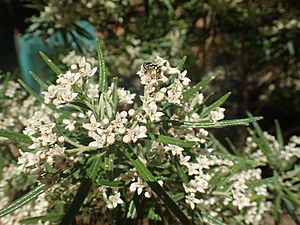Warty zieria facts for kids
Quick facts for kids Warty zieria |
|
|---|---|
 |
|
| Zieria tuberculata leaves and flowers | |
| Conservation status | |
| Scientific classification | |
| Genus: |
Zieria
|
| Species: |
tuberculata
|
The Warty Zieria (Zieria tuberculata) is a special plant. It belongs to the citrus family, just like oranges and lemons! This plant is found only in a small part of the south coast of New South Wales, Australia. It's a type of shrub, which is a bushy plant. Its branches and leaves feel a bit lumpy and hairy, almost like they have "warts." In late winter and spring, you can see its pretty creamy-white flowers. These flowers have four petals and grow in big groups.
Contents
What the Warty Zieria Looks Like
The Warty Zieria is a shrub that can grow up to about 3.5 meters (11 feet) tall. Its branches and leaves have small bumps, making them look "warty." They are also covered with tiny, star-shaped hairs. You might need a magnifying glass to see these hairs clearly!
Its leaves are made up of three narrow parts called leaflets. The middle leaflet is about 25 to 50 millimeters (1 to 2 inches) long and 2 to 3.5 millimeters (0.08 to 0.14 inches) wide. Each leaf has a stalk that is about 4 to 8 millimeters (0.16 to 0.31 inches) long. The top side of the leaflets is a dull green. The bottom side looks whitish and also has those small, warty bumps.
Flowers of the Warty Zieria
The flowers of the Warty Zieria are creamy-white. They grow in large groups, sometimes with up to 200 flowers! These groups appear where the leaves join the stem, which is called the leaf axil. Each group of flowers is shorter than the leaves themselves.
Each individual flower is about 5.2 to 7.3 millimeters (0.20 to 0.29 inches) across. It sits on a small stalk about 1.1 to 2.5 millimeters (0.04 to 0.10 inches) long. The flower has four small, triangular parts called sepals, which are less than 1.5 to 2.5 millimeters (0.06 to 0.10 inches) long. It also has four petals, each about 2.5 to 4 millimeters (0.10 to 0.16 inches) long. Like other Zieria plants, it only has four stamens. Stamens are the parts of the flower that make pollen. You can see these beautiful flowers from late winter through spring.
How it Got its Name
The Warty Zieria was officially described in 2002 by a scientist named James Armstrong. He published his description in a science journal called Australian Systematic Botany.
The second part of its scientific name, tuberculata, comes from a Latin word. It means "full of lumps" or "warty." This name perfectly describes the plant's bumpy branches and leaves!
Where the Warty Zieria Lives
This special plant is found only around the Mount Gulaga area in New South Wales. It likes to grow in places that are exposed and rocky. You can often find it on the edges of rainforests, where the forest meets open, rocky ground.
How the Warty Zieria Spreads its Seeds
The Warty Zieria relies on insects to help it reproduce. It is pollinated by different kinds of insects. Some beetles and flies visit the flowers to eat the pollen. Other flies come to drink the sweet nectar from the flowers. As they move from flower to flower, they carry pollen, helping the plant make new seeds.
Keeping the Warty Zieria Safe
The Warty Zieria is considered a "Vulnerable" species. This means it is at risk of disappearing if we don't protect it. Both the Australian government, under the Environment Protection and Biodiversity Conservation Act 1999 (EPBC Act), and the New South Wales government list it as vulnerable.
Scientists know of about 900 individual Warty Zieria plants. These plants are spread across eight different groups in an area of about 6 square kilometers (2.3 square miles).
The biggest dangers to the Warty Zieria are:
- Habitat destruction: This happens when animals like cows or goats graze (eat plants) in the areas where the Warty Zieria grows. This can damage the plants and their homes.
- Weeds: Invasive plants like lantana (Lantana camara) and ivy (Hedera helix) can grow quickly and take over the space. They can outcompete the Warty Zieria for sunlight, water, and nutrients, making it hard for the native plant to survive.
Protecting these areas and controlling the threats are important steps to help the Warty Zieria survive for future generations.


